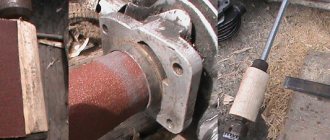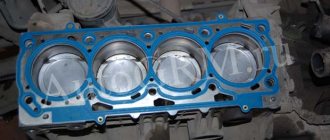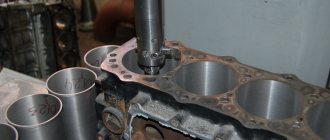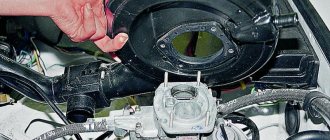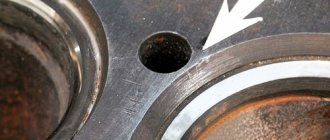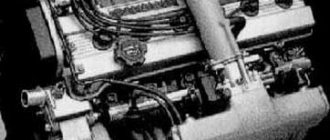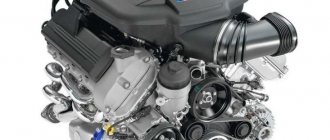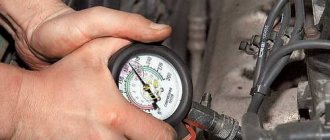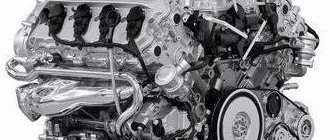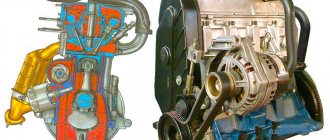Each car enthusiast has his own reasons why he wants to “increase” the power of his iron “horse”. Some people are fond of auto racing, others simply love driving fast. There are many ways to increase engine power: the difference between each method lies mainly in the cost of upgrading the power unit. But before choosing any method, you should not forget that such modifications of production cars increase fuel consumption, and in some cases, reduce their service life. And yet, how to increase engine power? Below we discuss several methods, ranging from the most common to the lesser known.
Volume increase
To achieve this, the cylinders are bored to the same distance, thereby increasing their volume. This method is quite common and not particularly expensive. Indeed, the number of horsepower increases and torque increases, but not by much. In addition, the intake and exhaust systems will not be able to work efficiently, because due to the increased volume, they will not have enough “strength” to fill the cylinders with fuel and remove exhaust gases as before. To eliminate this, you will have to increase the piston stroke, i.e. you will have to change the connecting rods. If you want to achieve greater effect, replace the standard cylinder head gasket with a thinner one. You can also trim the cylinder head itself, increasing the compression ratio. The addition is effective, but labor-intensive and requires replacement and adjustment of some components.
After completing the work, you will increase the number of horses in the engine and achieve higher torque. However, you will have to fill in gasoline with a higher octane number: if you had 92, you need to fill up with 95, and if you had 95, then 98. Increasing the engine size can be a good start for deeper transformations.
Increasing engine displacement
< Back
Next >
Increasing the displacement is the most radical way to increase engine power.
The working volume is determined by the number of cylinders, their diameter and the amount of movement (stroke) of the piston. Since the number of cylinders is a constant value, only the last two parameters can be varied.
The cylinder diameter is determined by the engine design. To increase it, in engines with cast iron cylinder blocks (F3R and VAZ), boring the cylinder block is used to install pistons of larger diameter, followed by honing (applying microroughness) to retain the oil film on the working surface of the cylinder wall. The easiest way to change the displacement is in engines with an aluminum cylinder block and plug-in wet liners (UZAM engine). In this case, to change the cylinder diameter, use the corresponding new liners available in the assortment. It should be borne in mind that the landing diameter of liners for the UZAM engine has different standard sizes - for UZAM-412 and UZAM-331.10 engines with a working volume of 1.5 liters, liners with an internal diameter of 82 mm were used with a landing diameter of 89 mm, and for UZAM engines of larger displacement - liners with a bore diameter of 92 mm. To install sleeves with an internal diameter of 85 mm in a standard 1.5 l block, you can machine the outer diameter of the sleeve seat to 89 mm; On sale there are also already machined liners with an internal diameter of 85 mm for the 1.5 cylinder block. It is impossible to install sleeves with an internal diameter of 88 mm in such a block without modifying it, because The wall thickness is only 0.5 mm. However, it is possible to bore a 1.5 liter cylinder block to install liners with a bore diameter of 92 mm, but this requires the use of complex special equipment. Cylinder blocks with a working volume of more than 1.5 liters have seats for liners with a diameter of 92 mm, so liners with an internal diameter of 85 mm and with an internal diameter of 88 mm can be installed in them.
It must be borne in mind that until 1992, UZAM cylinder blocks for engines with a displacement of 1.5 liters were produced to install liners with a bore diameter of 89 mm and a sealing copper gasket between the liner and the cylinder head. Later, these gaskets were eliminated in order to avoid corrosion in this place due to the formation of a galvanic couple in the silumin-copper-cast iron section, and the cylinder block began to be made with a higher fit for the liners by the thickness of these gaskets. Therefore, when installing machined liners in UZAM cylinder blocks produced before 1992, it is also necessary to install copper gaskets. In any case, it is necessary to check the protrusion of the sleeves from the block to ensure compliance with the specified parameters.
To increase the piston stroke in the cylinder, a modified crankshaft with an increased crank radius is used. There is a large selection of crankshafts for VAZ and UZAM engines, both standard and manufactured by tuning companies. For UZAM engines, standard steel crankshafts are produced with crank radii of 35, 37.5 and 40 mm, providing piston strokes of 70, 75 and 80 mm, respectively. manufactures crankshafts from high-strength cast iron VCh-70 with a crank radius of 42.5 mm for UZAM engines, providing a piston stroke of 85 mm. This piston stroke value for this engine is the limit, because at large values, the loads when moving the piston exceed the permissible ones.
When significantly boosting UZAM engines, they use liners and pistons from GAZ-24 and GAZ-3110 cars, having previously bored out the mounting hole in the cylinder block for the liner. When using liners of such a large diameter, it is necessary to modify the cylinder head, which consists of strengthening the channels at the interface between the liner and the cylinder head by partially welding them.
Below are examples of combinations of combustion chamber cylinder diameter and piston stroke for various UZAM engines and their displacement. Engine name indices are shown in brackets if engines were produced in this combination.
UZAM ENGINE LAYOUT OPTIONS
| Cylinder diameter, mm | Piston stroke, mm | |||
| 70 | 75 | 80 | 85 | |
| 82 | 1479 (UZAM-412, 331.10) | 1584 (UZAM-0102) | 1649 | 1861 |
| 85 | 1589 | 1702 (UZAM-3317) | 1816 (UZAM-3313,3318) | 1929 |
| 88 | 1703 (UZAM-327) | 1825 | 1946 (UZAM-248, 3320) | 2068 |
| 92* | 1861 | 1994 | 2127 | 2260 |
* the use of pistons with a diameter of 92 mm requires serious modification of the cylinder head design
VAZ engines are available in displacements of 1.3, 1.5, 1.6, 1.7 and 1.8. VAZ engines with a displacement of 1.6 (2106) and 1.8 (2130) were used serially in Moskvich cars.
VAZ ENGINE LAYOUT OPTIONS
| Engine model | 2106 | 21213 | 2130 | 21203 |
| working volume | 1568 | 1689 | 1774 | 1985 |
| cylinder diameter | 79 | 82 | 82 | 82 |
| piston stroke | 80 | 80 | 84 | 94 |
Increasing the working volume of VAZ engines by increasing the cylinder diameter is difficult to implement due to the proximity of the cooling system channels to the walls of the cast iron cylinder block.
When choosing an engine configuration in the process of increasing its displacement, one chooses between the “long-stroke” and “short-stroke” options, which determine which of the parameters - the piston stroke (the “long-stroke” option) or the cylinder diameter (the “short-stroke” option) will predominantly increase. It should not be forgotten that the engine displacement affects not only the maximum power, but also the speed at which the maximum power and torque values will be obtained. In general, as the piston stroke increases, maximum power and torque values are achieved at lower engine speeds. In addition, a “long-stroke” engine provides a lower maximum power value, but a higher torque value compared to a “short-stroke” engine. “Short-stroke” engines achieve maximum power at higher speeds and, with the same displacement, develop more power, but this is almost always accompanied by lower torque values at low speeds [19].
At different times, different trends prevailed with increasing engine displacement. Thus, in the 70s, the “short-stroke” UZAM-327 engine with a displacement of 1.7 liters was developed and passed a full cycle of tests. For a number of reasons, this engine was not put into production, and later a more “long-stroke” version of the engine with a displacement of 1.7 with the index 3317 appeared, produced with two variants of pistons - initially with pistons with a wedge-shaped surface without grooves and a unique cylinder head, and later - with pistons with a surface in the shape of truncated cones with grooves for valves, designed for a unified cylinder head. The piston designs in these engine variations are not interchangeable and older design pistons can only be used with a unique cylinder head and cannot be used with a common head.
Choosing pistons when boosting the engine
In the case of increasing the engine displacement to obtain “standard” options (for example, when moving to the next level of UZAM engines), it is possible to use standard pistons. The weight of the pistons in one engine should not exceed 3 g; standard pistons are divided into 4 weight groups, the number of which is stamped on the bottom of the piston. For pistons supplied in spare parts, instead of the group number, the mass of the piston in grams is indicated directly.
However, to implement non-standard options, the question arises of manufacturing non-standard pistons. Typically, such pistons are manufactured by specialized companies (for example,) by forging or isothermal stamping. In this case, you choose between standard (cast) and stamped pistons. There is an opinion about the undeniable advantages of forged pistons, but this is not entirely true.
In standard and moderately boosted engines, cast pistons provide more power than forged ones [19]. This happens for the following reasons:
— cast pistons have less wear on the piston ring grooves and very low thermal conductivity, leaving more heat in the combustion chamber, which improves the thermal efficiency of the engine;
— cast pistons provide less clearance in the cylinder and ensure a more stable position of the piston rings;
— cast pistons are in most cases lighter than forged ones;
— cast pistons have a significantly lower cost.
For everyday engines, cast pistons are preferred. Only when the engine operates constantly at high loads and elevated temperatures is it preferable to use forged pistons [19]. If specific power and other engine design features, such as unique size, shape, or position relative to the piston pin, require the use of a forged piston, the required running clearance between the piston and the cylinder wall must be maintained, which is a technical challenge for forged pistons due to the fact that that often forged pistons are made from alloys with a high coefficient of thermal expansion. Such pistons will have stable characteristics at high temperatures and high speeds, but in normal driving mode their performance is low - pistons with large gaps between the piston and the cylinder walls in a cold engine negatively affect fuel efficiency and increase oil consumption and exhaust toxicity [ 19].
When choosing a piston, it is necessary to ensure the smallest possible clearance at its skirt under all, and not just “gentle” operating conditions. The greater the thermal stability of the piston material alloy, the less the piston will expand when heated and the smaller the minimum guaranteed clearance between the piston and the cylinder wall will be.
To extend the service life of pistons, they are sometimes coated with special materials - hard molecular coatings or ceramics. The production of a solid molecular coating is similar to the metallization process. Such coatings have a very hard surface that reflects heat well. Ceramics absorb heat, but only in layers close to the surface. These layers ultimately act as very effective insulators, trapping heat and preventing it from penetrating the piston material. Applying a ceramic coating to the top of the piston prevents heat from being absorbed by the piston head. Unabsorbed heat is retained in the combustion chamber and increases gas pressure, increasing the thermal efficiency of the engine. Coating the piston crown helps increase engine power by 4-8% [19]. In addition, a coated piston head is much less sensitive to heat generation caused by detonation.
The shape of the piston is also important. Flat-bottomed pistons provide a better flame front in the combustion chamber than domed or concave-bottomed pistons.
Selection of piston rings
Particular attention should be paid to the selection of piston rings for a boosted engine. A common trend in high quality piston designs is the use of narrow piston rings. The thin ring is said to prevent ring vibration at high rpm and reduce cylinder friction. However, thin rings, due to their smaller contact surface with the cylinder wall, exert greater pressure on the walls; such rings cause accelerated wear of the cylinders and the rings themselves. Therefore, unless the engine is used primarily at speeds above 6000 rpm, it is preferable to use wide rings. In practice, the improvement in engine performance when using thin rings is so small that it can only be detected on a test bench or during a large number of test runs [19].
When making pistons, the position of the piston rings in the piston is also important, especially the position of the top ring. If the top ring is located high on the piston near the top of the piston, engine performance will be better due to the fact that less volume of inaccessible gases will be trapped in the bridge between the rings. However, if the ring is located too close to the top of the piston, the thin bridge over the ring groove can overheat and fail, since the top piston ring and the bridge above it work under very harsh conditions. The upper ring must not only provide high-quality sealing on working surfaces at very high temperatures, but also operate in an environment of high-temperature gases, maintaining its elasticity and good sealing, which determines the production technology and metallurgical features of the rings [19].
The ring material must have a low coefficient of friction, good anti-seizing properties and low wear rate. One of the first effective materials used for piston rings was ductile iron. It matches well with the characteristics of the cast iron used in the cylinder block, and its porous structure retains oil well, reducing wear. Its variety is also widely used - ductile cast iron, which has most of the qualities of cast iron and, in addition, can bend, which simplifies the installation of rings.
In forced engines, rings of a more complex design are used. Originally, the cast iron rings were coated with a layer of chromium, which helped resist abrasion and seizing even at very high temperatures and high pressures, and also provided very high wear resistance. The disadvantage of chrome-plated rings is their very high hardness - it is necessary to very accurately maintain the dimensions of the cylinder for the normal operation of such rings. Later, stainless steel rings began to be used - this material contains a large amount of chromium, so stainless steel rings have most of the properties of chrome-plated cast iron rings [19]. Stainless steel resists high temperatures better than chrome-plated cast iron.
To increase the service life of the rings and ensure their rapid break-in, molybdenum rings appeared - a ring with a cast iron base with a molybdenum coating. Molybdenum has anti-wear layers of chromium and often surpasses them; these rings are more durable, easy to break in, and more reliable. Currently, molybdenum rings are most widely used in high-performance engines.
There are also ceramic piston rings made of a hard and wear-resistant non-metallic material, but their use in engines still faces difficulties in mating such rings with the cylinder walls; this technology is currently in its development stage.
In addition to the material of the piston ring, its design is important. For example, the ring may have a deliberate slight twist, i.e. The top and bottom surfaces of the ring do not lie flat in the groove, but are slightly inclined, and only the top or bottom edge of the working surface of the ring contacts the cylinder bore. The rings are designed to speed up the break-in of the piston ring surfaces and cylinder walls and help seal the ring at the top and bottom of the groove. The amount of ring twist is very small and is usually achieved by chamfering the inside edge of the ring. The chamfer reduces small stresses along the inner edge and allows the ring to relax unevenly, causing it to slightly deform causing the required twisting [19].
To improve the sealing of the cylinders from increased gas pressure, drilling a number of very small holes in the upper part of the piston, reaching the inside of the groove of the upper compression ring, is also used. When the cylinder is pressurized, the gases flow through these passages and force the top compression ring against the cylinder wall, providing a very good seal, but increasing wear on the cylinder at the top. However, this significantly increases the friction of the rings against the cylinder walls, which leads to additional losses.
The second compression ring provides an additional seal for gases passing through the upper ring, so their operating pressure and temperature are significantly lower, and, as a result, the requirements for the materials for their manufacture are significantly lower. However, the second ring has an important additional function - it assists the oil scraper ring by acting as a “scraper”, preventing oil from entering the combustion chamber and causing detonation. Sometimes these rings are specially made beveled, so that the bevel is smaller at the top edge of the ring, which helps the operation of the oil control ring - such a ring will move on top of the oil when the piston moves up and will remove it when the piston moves down.
Second compression rings without a gap are often used, or more precisely, with a very small gap; when using them, the engine runs in faster and produces slightly more power, as it prevents power losses by reducing the blow-by of crankcase gases [19].
The design of the oil scraper ring is also important. Engine oil remaining in the combustion chamber reduces the octane number of the fuel, which can lead to detonation, and also leads to the formation of carbon deposits in the combustion chamber and on the piston crown, which causes a decrease in engine power. A good oil control ring supports its top and bottom edges with a central spacer. Cheap rings use wavy separators of the upper and lower edges, but this does not ensure the correct position of the edges - as engine speed increases, inertial forces tend to straighten the wavy separator and the ring is screwed into the groove, and the oil passes over the edges.
Selection of connecting rods
Usually, when boosting an engine, standard connecting rods for a given engine model are used. However, it is necessary to assess their condition. The weight of the connecting rods in one engine should not exceed 4 g, and excess metal should be removed. To achieve this, the connecting rod has large balancing pads at both ends of the connecting rod. It is advisable to achieve the minimum possible weight of all connecting rods by removing metal from these pads and constantly weighing it.
Bent or even slightly deformed connecting rods will reduce engine power because... they hold the piston at an angle, increasing friction. Of course, the alignment of the connecting rods must be checked before assembling the engine, as well as the size of the big hole of the connecting rod - if the connecting rod has been subjected to increased loads or detonation, the hole in the connecting rod head may be deformed or enlarged. You should also check the connecting rods for cracks.
If the engine is to be operated at high speeds, it is better to select connecting rods with a large end bore so that it falls within the lower tolerance limit, which increases the compression of the connecting rod bearing.
It is also necessary to pay attention to the connecting rod bolts - if these bolts stretch under load, this will loosen the clamp and can lead to the liners turning. If during disassembly of the engine it is discovered that the bearings have rotated, this connecting rod should not be reused.
Publication date: 2007-10-17
< Back
Next >
Installing lightweight pistons or rings
This refers to forged elements. They are very durable and lightweight. However, such an increase in engine power can cause a number of problems:
- disassembling the power unit and installing new parts into it must be done at a high professional level;
- turning to specialists will force you to shell out a decent amount of money;
- During the rework, the brake, exhaust, intake systems, as well as the gearbox will have to be modified.
Effect of cylinder diameter and piston stroke on the effective efficiency of an internal combustion engine
Basic steps when performing finishing:
- Reduced weight characteristics of the crankshaft and connecting rod-piston group.
- Grinding and lapping of mating surfaces of collectors.
- Calibration and adjustment of electronic systems responsible for the operation of the motor unit.
- Increasing or decreasing gear ratios.
In-depth tuning of the VAZ 2106 engine is primarily associated with the selection and installation of a special type of crankshaft instead of a standard part. This part is mounted with a larger crank. For a block bored to accommodate a piston group of increased diameter, cylinders equipped with rings of a T-shaped compression type configuration are selected.
Next, a technological adjustment is made to the settings of all component elements of the engine with the main task of increasing the compression ratio in the engine cylinder. This indicator is directly related to the angular value of the gas distribution phases and the throttle position.
The positional change of the gas camshaft is carried out by an adjustable drive gear, which makes it possible to fill the combustion chamber with fuel with a high air concentration. The most effective option for engine tuning is considered to be the installation of a turbine on the power plant and so-called vehicle equipment. “direct flow”, i.e. direct-flow gas outlet system. It is advisable to select such auxiliary equipment with an engine specialist. If the car is upgraded with a turbine, this will greatly increase the dynamic parameters of the engine.
This type of modernization, such as engine chip tuning, makes it possible to optimize the functionality of the vehicle. Changes in dynamic parameters occur without the use of mechanical adjustments. This service is carried out exclusively in cars that have an ECU system. The presence of appropriate software in the ECU allows you to control and change parameters for ignition settings, fuel supply, flow meter, etc.
One of the progressive ways to tune an engine is to adjust the vehicle’s ignition system. For these purposes, it is practiced to install an electronic switching ignition, which among motorists is called contactless, i.e. without the participation of mechanical switching components (breaker contacts). In addition to this, it is necessary to replace the spark plug elements of the system with higher quality products.
Related articles:
- ALL-wheel drive FORD TRANSIT Page 1 of 5 Years of painstaking and persistent work have brought their results. Ford Transit like this...
- BMW 7 E38 BMW 7-Series e38 (1998-2001) – third generation Since the second generation was discontinued, there was…
- ZIS 5 CAR Car ZIS-5 (1933-1941), ZIS-5V (1941-1947), ZIS-50 (1948), UralZIS-5 (1947-1955), UralZIS -355 (1956-1957), UralZIS-355V (1957-1958).…
- MERCEDES WITH FLASHING LIGHT Car accident of Olga AlexandrinaGolikov Albert Alexandrovich Articles | Society Print version “Road accident…
Installing a zero air filter
The essence of the modification is to reduce the resistance to the air flow entering the cylinders. The fact is that the standard part is made of durable material that does not allow a large volume of air to pass through. But it is best to install a zero-resistance filter in a “set” with other upgrades, otherwise it will give minimal effect. Do not forget that the filtering capabilities of such a part are worse than those of a standard spare part.
Ratio of piston stroke to cylinder diameter
The quotient of the piston stroke S divided by the cylinder diameter D is the widely used S/D ratio. The point of view on the size of the piston stroke has changed during the development of engine building.
At the initial stage of automobile engine building, the so-called tax formula was in effect, on the basis of which the tax levied on engine power was calculated taking into account the number and diameter D of its cylinders. The classification of engines was also carried out in accordance with this formula. Therefore, preference was given to engines with long strokes in order to increase engine power within a given tax bracket. The engine power increased, but the increase in rotational speed was limited by the permissible average piston speed. Since the engine gas distribution mechanism during this period was not designed for high speed, limiting the rotation speed by the piston speed did not matter.
Once the described tax formula was abolished, and the classification of herd engines was carried out in accordance with the cylinder displacement, the piston stroke began to decrease sharply, which made it possible to increase the engine speed and thereby engine power. In larger diameter cylinders it has become possible to use larger valves. Therefore, short-stroke engines with S/D ratios reaching 0.5 were created. Improvements in the gas distribution mechanism, especially when using four valves per cylinder, made it possible to increase the rated engine speed to 10,000 min-1 or more, as a result of which the specific power quickly increased.
Currently, much attention is paid to reducing fuel consumption. Studies of the influence of S/D carried out for this purpose showed that short-stroke engines have increased specific fuel consumption. This is caused by the large surface of the combustion chamber, as well as a decrease in the mechanical efficiency of the engine due to the relatively large magnitude of the progressively moving masses of the parts of the connecting rod and piston set and the increase in losses on the drives of auxiliary equipment. With a very short stroke, it is necessary to lengthen the connecting rod so that the lower part of the piston skirt does not touch the crankshaft counterweights. The mass of the piston with a decrease in its stroke also decreased slightly when using recesses and cutouts on the piston skirt. To reduce the emission of toxic substances in exhaust gases, it is more advisable to use engines with a compact combustion chamber and a longer piston stroke. Therefore, engines with very low S/D ratios are now being abandoned.
| Rice. 1 |
| The influence of the ratio of piston stroke S to cylinder diameter D on the average effective pressure pe of racing cars |
The dependence of the average effective pressure on the S/D ratio for the best racing engines, where a decrease in pe is clearly visible at low S/D ratios, is shown in Fig. 1. Currently, an S/D ratio equal to or slightly greater than one is considered more profitable. Although with a short stroke of the piston the ratio of the cylinder surface to its working volume at the piston position at BDC is less than with long-stroke engines, the lower zone of the cylinder is not so important for heat removal, since the temperature of the gases has already dropped noticeably.
A long-stroke engine has a more favorable ratio of the cooled surface to the volume of the combustion chamber when the piston is at TDC, which is more important, since during this period of the cycle the gas temperature, which determines heat loss, is the highest. Reducing the heat transfer surface during this phase of the expansion process reduces heat losses and improves the engine's indicator efficiency.
Last updated 03/02/2012 Published 09/27/2011
Top
Chip tuning (reprogramming)
The method is simple: you don’t need to open the engine and you don’t need to buy anything either. If you entrust this matter to a specialist, the power plant will fully reveal all its capabilities that the automaker hides in order to increase the life of the car. The increase in engine power will be 10-15%. Most often, tuners increase the amount of fuel supplied.
The engine will become stronger, and emissions into the atmosphere will be more harmful. You can also unlock the crankshaft speed limiter. For example, Honda once produced 160 hp without turbocharging. With. with a cylinder volume of only 1.6 liters. This was achieved by spinning the engine up to 8 thousand rpm.
Engine power on the VAZ 2109 and increasing it yourself
Engine VAZ 2109
Most of the “nines”, which a certain part of motorists drive today, are equipped with a carburetor engine. In this case, many people are not satisfied with the engine power of the VAZ 2109 and some are trying to increase it. The car is taken to a service station, where various methods of increasing power are carried out. In this article we will find out what you can do with your own hands if the engine of a VAZ 2109 does not develop full power.
Installing a nitrous oxide bottle
This method allows you to get a sharp acceleration, but only for a short period of time. The cylinder is connected to the fuel system: nitrous oxide promotes the formation of more oxygen, which “forces” the fuel to burn better and faster. The method is especially good for sports cars, for which a short-term jerk often makes all the difference. Negative aspects of the method:
- high cost of components;
- decent cost of work;
- reduction of motor life.
Using turbocharging
It is considered one of the best methods for increasing the amount of horsepower in the engine. Many automakers already equip their cars with turbines at the factory. If you have just such a machine, then to increase power it is enough to install a stronger unit: the operation is not very complicated and requires a minimum of modifications. The situation is more complicated with atmospheric cars. This means not only the installation itself, but also the operation:
- air and oil filters will require more frequent replacement;
- The engine will have to be warmed up even in warm weather.
As for installing the described unit on naturally aspirated engines, do not forget about additional cooling of the turbine: usually an intercooler is used, the volume of coolant is increased, and the fan performance is increased. Plus, you will have to install more efficient injectors.
Alternative methods
An easier method is to replace the air filter. Fuel consumption does not increase here, but power increases by 10%. Along with this procedure, you can remove roughness on the cylinders and grind the intake channels. In other words, carry out a “spring cleaning” of the VAZ 2114 engine. But you need to be careful when installing a turbocharger. Despite the apparent ease of installation and standard equipment (such a part can be bought at any car market, just knowing the model of your car), this system will place a very large load on the transmission.
The simplest option is chip tuning. We are talking about reprogramming the engine computer system. Today there are a lot of tools, each of which changes a certain aspect of the work. For example, you can reduce fuel consumption, increase acceleration power, and so on. But here you cannot do without special equipment - a programmer. But after installing the electronic board on the engine, you can independently and repeatedly change the parameters.
Exhaust pipe replacement
This refers to the installation of a direct-flow part that does not have a resonator. This reduces the muffler's resistance to exhaust gases, which begin to move much faster. As a result, the power plant spends less “force” on removing exhaust gases from the exhaust system and more energy on spinning the crankshaft. Increase in power – up to 15%. Not bad at all, but:
- engine operation will be accompanied by an unpleasant loud sound;
- An increased content of harmful substances in the exhaust worsens the environmental situation.
Effect of cylinder diameter and piston stroke on the effective efficiency of an internal combustion engine
Author: Julius Mackerle
32634 2
The volume of the combustion chamber to a certain extent indicates the amount of heat introduced. The calorific value of the incoming charge in a gasoline engine is determined by the ratio of air to fuel, which is close to stoichiometric. Clean air is supplied to the diesel engine, and the fuel supply is limited by the degree of combustion incompleteness, at which smoke appears in the exhaust gases. Therefore, the connection between the amount of heat input and the volume of the combustion chamber is quite obvious.
A sphere has the smallest ratio of surface to a given volume. Heat is removed into the surrounding space by the surface, so the spherical mass cools to the least extent. These obvious relationships are taken into account when designing the combustion chamber. However, one should keep in mind the geometric similarity of engine parts of different sizes. As is known, the volume of a sphere is equal to 4/3∙π∙R3, and its surface is 4∙π∙R2, and thus, with increasing diameter, the volume increases faster than the surface, and, therefore, a sphere of larger diameter will have a smaller value surface to volume ratio. If the surfaces of a sphere of different diameters have the same temperature differences and the same heat transfer coefficients α, then the larger sphere will cool more slowly.
Motors are geometrically similar when they have the same design but differ in size. If the first engine has a cylinder diameter, for example, equal to one, and the second engine has it 2 times larger, then all the linear dimensions of the second engine will be 2 times larger, the surfaces will be 4 times larger, and the volumes will be 8 times larger than those of the first engine. However, it is not possible to achieve complete geometric similarity, since the dimensions of, for example, spark plugs and fuel injectors are the same for engines with different cylinder diameter sizes.
From the geometric similarity, we can conclude that a larger cylinder also has a more acceptable surface-to-volume ratio, so its heat losses when cooling the surface under the same conditions will be less.
When determining power, however, some limiting factors must be taken into account. Engine power depends not only on the size, i.e., the volume of the engine cylinders, but also on its rotational speed, as well as the average effective pressure. The engine speed is limited by the maximum average piston speed, the weight and the perfect design of the crank mechanism. The maximum average piston speeds of gasoline engines range from 10 to 22 m/s. For passenger car engines, the maximum average piston speed reaches 15 m/s, and the average effective pressure at full load is close to 1 MPa.
The engine displacement and its dimensions are determined not only by geometric factors. For example, the thickness of the walls is determined by technology, and not by the load on them. Heat transfer through the walls does not depend on their thickness, but on the thermal conductivity of their material, heat transfer coefficients on the surfaces of the walls, temperature differences, etc. Fluctuations in gas pressure in pipelines propagate at the speed of sound, regardless of the size of the engine, clearances in bearings are determined by the properties of the oil film and etc. Some conclusions regarding the influence of the geometric dimensions of the cylinders, however, need to be drawn.
Replacing standard engine parts with sports ones
The idea is to replace factory parts with equivalents found on sports cars. Such an operation will allow the technical parameters of the power unit to be raised to the maximum height. However, it is worth remembering: the car must be adapted to other loads. We'll have to change the gearbox and redo the brake system. The advantages of this method include maintaining the original engine life and the same fuel consumption.
Increasing the power of a diesel unit
Diesel, when compared with a gasoline engine, has a number of advantages: efficiency and relative “tolerance” to fuel quality. An engine running on diesel fuel pulls better at the “lower” range. As for increasing power, most of the methods listed above are applicable to a diesel engine: boring cylinders, installing turbocharging, chip tuning, etc. But there are also features of improvement.
Modules for increasing power characteristics
We are talking about specially designed units that interact with the vehicle’s fuel system. They do not affect the operation of the electronic control unit in any way; they simply exercise additional control over the operation of the electronic sensors. There are four types of modules:
- A block that changes the pulses that control the operation of the injectors. Here the module’s task is to slow down or speed up the needle rise. This reduces diesel fuel consumption and improves its combustion. This happens due to a change in the ignition timing. The module is easy to install and can work with any modern diesel units.
- A block that influences the operation of the high pressure fuel pump. The module operates in conjunction with a sensor that provides information about fuel pressure. At the same time, the data is underestimated. This leads to an increase in pressure in the injection pump. The result is preservation of the operational life of the power unit while improving dynamics. The unit only works with diesel engines that use a mechanical method of supplying diesel fuel and were manufactured before 2008.
- A unit that works with the fuel rail sensor. This module is also engaged in “deception”, supplying the ECU with data about a decrease in pressure in the ramp. He begins to “think” that the dynamic characteristics of the engine are insufficient and changes the intensity of the injectors’ operation. Power increases and fuel consumption decreases.
- A module that optimizes the operation of the ECU (more precisely, its processor). The purpose of the block is to determine the pressure in the fuel system. If its value is large, a signal is sent “ordering” to increase the injector timing. That is, the module is capable of changing the engine operating mode without the participation of an electronic control unit. The unit is not “engaged” in supplying false information and is installed in a high-pressure system. Works well with any modern diesel installation.
The advantages of the above blocks include ease of installation, savings in diesel fuel consumption and increased power. However, this reduces the service life of the cylinder block, injectors, and fuel pump. At the same time, the emission of harmful substances into the atmosphere increases.
Increasing the power and engine capacity of the VAZ 2114
The VAZ 2114 engine size and its characteristics changed and improved throughout the entire production period, from 2001 to December 2013.
The first batch of VAZ 2114 cars were equipped with 1.5 liter 8-valve injection units. After the modernization in 2007, new engines with a volume of 1.6 liters were installed on the “fourteenths”. New production VAZ-11183-1000260 engines received environmental class 3, Euro-3. The most powerful of all VAZ units was assembled and installed on the Lada Priora in 2010. The power of this power plant was 98 horsepower. A common feature of all engines of the VAZ 2114 model is that they are 4-stroke and have the same distributed fuel injection system. Fuel is supplied to the engine cylinders thanks to installed injectors. Today, this method of powering engines is the most efficient of all fuel supply schemes. The engines have a standard, in-line appearance, and their camshaft is located on top. A closed liquid system is used to cool the units. Some mechanisms are lubricated with oil under pressure, others by spraying oil.
